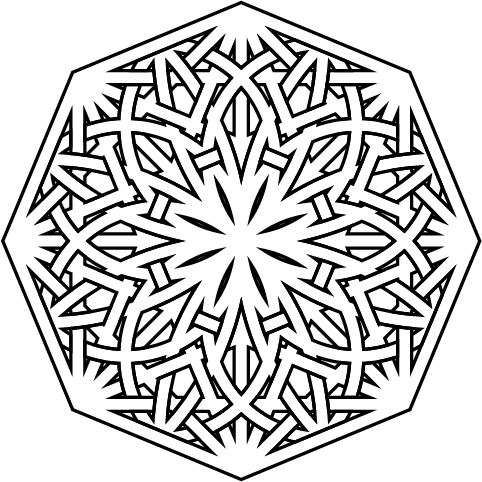Exploring Fourth Dimension 4D Art Geometry
Share
Exploring the Fourth Dimension: The Art and Philosophy of 4D Geometry

In a world constrained by three dimensions, the concept of 4D art opens doorways to realms beyond ordinary perception. As an artist known as Pardesco (Randall Morgan), my passion lies in visualizing these higher dimensional spaces through innovative techniques that bridge mathematics, technology, and artistic expression.
The Journey into 4D Art
My artistic exploration began with a deep fascination for geometric complexity. While many artists work within the familiar confines of three-dimensional space, I found myself drawn to the mysterious fourth dimension—a realm that exists mathematically but remains beyond direct human perception.
This curiosity led me to spend years developing proprietary techniques for creating the most detailed geometric drawings possible. What started as an examination of models available in software like Stella4D evolved into a profound artistic quest to make the invisible visible.
From Mathematical Concepts to Physical Sculptures

One of the most challenging aspects of 4D artwork is translating abstract mathematical concepts into tangible forms. The complexity of higher-dimensional geometry creates unique obstacles for traditional artistic methods.
My breakthrough came through parametric design techniques using Rhino and Grasshopper. By exporting .dxf linework from Stella4D, I developed a method to create single closed meshes from the edges of 4D shapes—a crucial requirement for successful 3D printing.
The results are physical manifestations of fourth-dimensional objects like the 120-cell, 600-cell, 24-cell, and 48-cell—complex polyhedra that exist naturally in four dimensions. Each sculpture represents a three-dimensional shadow or projection of these higher-dimensional forms, similar to how a cube casts a hexagonal shadow when properly oriented.
Innovative Techniques in 4D Digital Art

Beyond physical sculptures, my artistic journey expanded into digital realms. Using Adobe Illustrator, I created digital art based on edge networks of 3D meshes, applying gradient and glow effects to reveal new aspects of 4D geometry never before visualized.
Perhaps most innovative is my development of gradient mapping on 3D projections. These "heatmap" style renditions employ custom scripting to represent the distortion occurring in the fourth dimension. The colors transition from the outer edges toward the centroid, creating a visual language that hints at the higher-dimensional properties of these objects.
For those who appreciate the precision of analog processes, I've also used pen plotters to create physical drawings of the vector outlines derived from these complex meshes—each line representing an edge in a projected 4D shape.
4D Art in Historical Context
Though 4D art remains a relatively unexplored frontier, it has notable precedents in art history. Salvador Dalí's "Crucifixion (Corpus Hypercubus)" from 1954 stands as perhaps the most famous example, depicting Christ crucified on the three-dimensional "unfolding" of a four-dimensional hypercube (or tesseract).
Throughout the 20th century, artists like Marcel Duchamp, Man Ray, and later M.C. Escher explored dimensional paradoxes in their work. More recently, digital artists have embraced higher-dimensional concepts, though few have dedicated themselves to the mathematical rigor and innovative techniques required for true 4D representation.
A Personal Philosophy of Higher Dimensions

My artistic practice is inseparable from a deeper philosophical perspective on higher dimensions. I believe these higher realms could be more "real" than our physical reality—perhaps eternal frameworks built on light and geometry that transcend time itself.
This perspective was crystallized during a profound vision where I perceived complex higher-dimensional shapes, glowing with vibrant neon colors, pulsing and changing form. They emanated from the center of a horn torus-like structure that seemed conscious, representing a human soul in higher dimensions forming like a quasicrystal. This experience suggested to me that the soul, like a beautiful song, is defined by both its highs and lows.
The Future of 4D Art and Digital Exploration
As one of the few artists deeply exploring 4D geometry, I hope to inspire others to expand on this subject. The recent advancements in artificial intelligence are making complex topics increasingly accessible, potentially opening this field to more creative minds.
The intersection of mathematical precision, technological innovation, and artistic vision creates a unique space for exploration. While we cannot directly perceive the fourth dimension, art offers a window into its mathematical beauty and philosophical implications.
Through 3D printed sculptures, digital renderings, plotted drawings, and gradient-mapped visualizations, my work aims to build bridges between dimensions—allowing viewers to glimpse the elegant complexity that exists just beyond our perceptual limits.
❖ SUPPORT MY SACRED GEOMETRY WORK ❖
→ Just loved this article? Buy me a coffee ($5)
→ Want to go deeper? Get my comprehensive Sacred Geometry E-Book ($4.99)
→ Ready to transform your space? Explore my handcrafted Sacred Geometry Wall Art (from $15)
As an independent artist, every purchase directly supports creating more free content like this article. Thank you!
